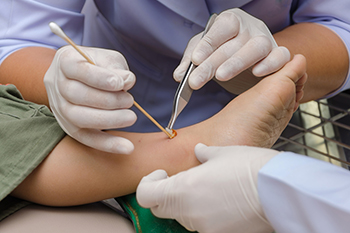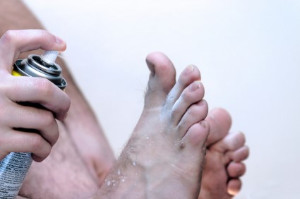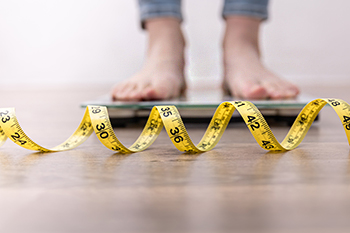April 2023
Arterial Ulcers

Wounds on the feet are varied and can have many different symptoms. There are several different types of wounds that a patient may develop on their feet. For example, arterial ulcers are one specific type of wound on the foot. Some people may be unfamiliar with this particular kind of wound. It is important to note that an arterial ulcer occurs when a break in the skin of the foot lets bacteria touch the tissue, and the ulcer will not heal properly due to blocked arteries in the leg. If an individual is living with an arterial ulcer, they may feel pain that can vary from case to case. To help arterial ulcers heal, a dressing may be used. The dressings essentially facilitate the healing of an ulcer by keeping it clean and protected. If you are someone that is currently suffering from an arterial ulcer, it is recommended that you contact a podiatrist today for treatment and advice.
Wound care is an important part in dealing with diabetes. If you have diabetes and a foot wound or would like more information about wound care for diabetics, consult with John McGhan, DPM from Gold Canyon Foot & Ankle. Our doctor will assess your condition and provide you with quality foot and ankle treatment.
What Is Wound Care?
Wound care is the practice of taking proper care of a wound. This can range from the smallest to the largest of wounds. While everyone can benefit from proper wound care, it is much more important for diabetics. Diabetics often suffer from poor blood circulation which causes wounds to heal much slower than they would in a non-diabetic.
What Is the Importance of Wound Care?
While it may not seem apparent with small ulcers on the foot, for diabetics, any size ulcer can become infected. Diabetics often also suffer from neuropathy, or nerve loss. This means they might not even feel when they have an ulcer on their foot. If the wound becomes severely infected, amputation may be necessary. Therefore, it is of the upmost importance to properly care for any and all foot wounds.
How to Care for Wounds
The best way to care for foot wounds is to prevent them. For diabetics, this means daily inspections of the feet for any signs of abnormalities or ulcers. It is also recommended to see a podiatrist several times a year for a foot inspection. If you do have an ulcer, run the wound under water to clear dirt from the wound; then apply antibiotic ointment to the wound and cover with a bandage. Bandages should be changed daily and keeping pressure off the wound is smart. It is advised to see a podiatrist, who can keep an eye on it.
If you have any questions, please feel free to contact our office located in Gold Canyon, AZ . We offer the newest diagnostic and treatment technologies for all your foot care needs.
Contagious Athlete’s Foot

Atheltes’ foot is a common foot condition that may recur if prompt treatment is not received. It is considered to be a fungal infection, and is contagious. The fungus that causes this uncomfortable ailment lives and thrives in warm and moist environments, such as public swimming pools, shower room floors, and similar areas. Common symptoms of athlete’s foot can include itchiness between the toes, flaky skin, and small blisters may develop in severe cases. Temporary relief may be found when the feet are washed and dried, followed by applying an appropriate cream or powder. This will unlikely bring lasting results, and permanent relief can be obtained from a podiatrist who can prescribe correct medication. If you have developed athlete’s foot, it is suggested that you consult with this type of doctor who can offer you the treatment that is needed.
Athlete’s Foot
Athlete’s foot is often an uncomfortable condition to experience. Thankfully, podiatrists specialize in treating athlete’s foot and offer the best treatment options. If you have any questions about athlete’s foot, consult with John McGhan, DPM from Gold Canyon Foot & Ankle. Our doctor will assess your condition and provide you with quality treatment.
What Is Athlete’s Foot?
Tinea pedis, more commonly known as athlete’s foot, is a non-serious and common fungal infection of the foot. Athlete’s foot is contagious and can be contracted by touching someone who has it or infected surfaces. The most common places contaminated by it are public showers, locker rooms, and swimming pools. Once contracted, it grows on feet that are left inside moist, dark, and warm shoes and socks.
Prevention
The most effective ways to prevent athlete’s foot include:
- Thoroughly washing and drying feet
- Avoid going barefoot in locker rooms and public showers
- Using shower shoes in public showers
- Wearing socks that allow the feet to breathe
- Changing socks and shoes frequently if you sweat a lot
Symptoms
Athlete’s foot initially occurs as a rash between the toes. However, if left undiagnosed, it can spread to the sides and bottom of the feet, toenails, and if touched by hand, the hands themselves. Symptoms include:
- Redness
- Burning
- Itching
- Scaly and peeling skin
Diagnosis and Treatment
Diagnosis is quick and easy. Skin samples will be taken and either viewed under a microscope or sent to a lab for testing. Sometimes, a podiatrist can diagnose it based on simply looking at it. Once confirmed, treatment options include oral and topical antifungal medications.
If you have any questions, please feel free to contact our office located in Gold Canyon, AZ . We offer the newest diagnostic and treatment technologies for all your foot care needs.
Obesity and Foot Problems in Children

When a young child is obese, this can ultimately wreak havoc on the health of their feet and broader well-being for many reasons. First, when a child is still growing, their bones are moldable. This means that excess weight can precipitate significant changes in the structure of the feet. Second, young children who are overweight for their age might have foot conditions that, in turn, make it more difficult for them to be active. This can then contribute to a cycle that reinforces their obesity. If you are a parent caring for a young child who is overweight or obese, it is highly suggested that you schedule an appointment with a podiatrist today. A podiatrist can assist you in caring for the health of your child’s feet by answering any questions you might have or providing any treatment your child may need.
Obesity has become very problematic at this point in time and can have extremely negative effects on the feet. If you’re an obese individual and are concerned about your feet, contact John McGhan, DPM from Gold Canyon Foot & Ankle. Our doctor can provide the care you need to keep you pain-free and on your feet.
Obesity and Your Feet
Since your feet are what support your entire weight when standing, any additional weight can result in pain and swelling. Being overweight is one of the main contributors to foot complications.
Problems & Complications
Extra Weight – Even putting on just a few extra pounds could create serious complications for your feet. As your weight increases, your balance and body will shift, creating new stresses on your feet. This uneven weight distribution can cause pain, even while doing the simplest tasks, such as walking.
Diabetes – People who are overweight are at serious risk of developing type-2 diabetes, which has a drastic impact on the health of your feet. As you get older, your diabetes might worsen, which could lead to loss of feeling in your feet, sores, and bruises. You could also become more prone to various infections.
Plantar fasciitis – Pressure and stress that is placed on muscles, joints, and tendons can trigger plantar fasciitis, which is an inflammation of tissue that forms along the bottom of the foot.
If you have any questions please feel free to contact our office located in Gold Canyon, AZ . We offer the newest diagnostic and treatment technologies for all your foot and ankle needs.
Do Your Child's Feet Hurt?
What Is a Brannock Device?

Many foot conditions may be avoided when shoes fit correctly. Bunions, hammertoes, and ingrown toenails are uncomfortable ailments that fit this category. To determine the correct shoe size, it is beneficial to have the feet measured. This can be accomplished by using a Brannock device, which is found in the majority of shoe stores. If this is not available, the feet can be measured by tracing them on a piece of paper while standing up. Shoes should be tried on and walked in before determining the proper size. This is successful in noticing if the shoe is too small or too large, and other shoes may need to be chosen if they do not fit correctly. If you would like additional information regarding how to buy shoes that fit properly, it is suggested that you confer with a podiatrist.
It is important to find shoes that fit you properly in order to avoid a variety of different foot problems. For more information about treatment, contact John McGhan, DPM from Gold Canyon Foot & Ankle. Our doctor will treat your foot and ankle needs.
Proper Shoe Fitting
Shoes have many different functions. They cushion our body weight, protect our feet, and allow us to safely play sports. You should always make sure that the shoes you wear fit you properly in order to avoid injuries and deformities such as: bunions, corns, calluses, hammertoes, plantar fasciitis, stress fractures, and more. It is important to note that although a certain pair of shoes might be a great fit for someone else, that doesn’t mean they will be a great fit for you. This is why you should always try on shoes before buying them to make sure they are worth the investment. Typically, shoes need to be replaced ever six months to one year of regular use.
Tips for Proper Shoe Fitting
- Select a shoe that is shaped like your foot
- Don’t buy shoes that fit too tight, expecting them to stretch to fit
- Make sure there is enough space (3/8” to ½”) for your longest toe at the end of each shoe when you are standing up
- Walk in the shoes to make sure they fit and feel right
- Don’t select shoes by the size marked inside the shoe, but by how the shoe fits your foot
The shoes you buy should always feel as good as they look. Shoes that fit properly will last longer, feel better, and improve your way of life each day.
If you have any questions, please feel free to contact our office located in Gold Canyon, AZ . We offer the newest diagnostic and treatment technologies for all your foot care needs.

